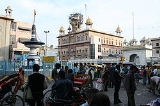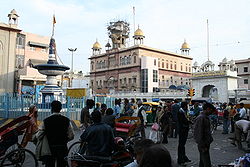
Gurdwara Sis Ganj Sahib
Encyclopedia

Gurdwara
A Gurdwara , meaning the Gateway to the Guru, is the place of worship for Sikhs, the followers of Sikhism. A Gurdwara can be identified from a distance by tall flagpoles bearing the Nishan Sahib ....
s in Delhi
Delhi
Delhi , officially National Capital Territory of Delhi , is the largest metropolis by area and the second-largest by population in India, next to Mumbai. It is the eighth largest metropolis in the world by population with 16,753,265 inhabitants in the Territory at the 2011 Census...
. First established in 1783 by Baghel Singh
Baghel Singh
Baghel Singh was an important military general during turbulent times in Punjab in the 18th century. He was born in the village of Chabal Kalan near the city of Tarn Taran Sahib in the Taran Taran district...
to commemorate the martyrdom site the ninth Sikh Guru, Guru Tegh Bahadur. Situated in Chandni Chowk
Chandni Chowk
Chandni Chowk , originally meaning moonlit square or market, is one of the oldest and busiest markets in Old Delhi, now in central north Delhi, India...
in Old Delhi
Old Delhi
Old Delhi , walled city of Delhi, India, was founded as Shahjahanabad by Mughal Emperor Shahjahan in 1639. It remained the capital of the Mughals until the end of the Mughal dynasty....
, it marks the site Sikh Guru was beheaded on the orders of the Mughal emperor on the 11th of November, 1675, Aurangzeb
Aurangzeb
Abul Muzaffar Muhy-ud-Din Muhammad Aurangzeb Alamgir , more commonly known as Aurangzeb or by his chosen imperial title Alamgir , was the sixth Mughal Emperor of India, whose reign lasted from 1658 until his death in 1707.Badshah Aurangzeb, having ruled most of the Indian subcontinent for nearly...
, for refusing to convert to Islam.
History
The site in the Chandni ChowkChandni Chowk
Chandni Chowk , originally meaning moonlit square or market, is one of the oldest and busiest markets in Old Delhi, now in central north Delhi, India...
area of Old Delhi
Old Delhi
Old Delhi , walled city of Delhi, India, was founded as Shahjahanabad by Mughal Emperor Shahjahan in 1639. It remained the capital of the Mughals until the end of the Mughal dynasty....
, is where the ninth Sikh Guru, Guru Tegh Bahadur was beheaded on the orders of the Mughal
Mughal Empire
The Mughal Empire , or Mogul Empire in traditional English usage, was an imperial power from the Indian Subcontinent. The Mughal emperors were descendants of the Timurids...
emperor in 1675 AD, Aurangzeb
Aurangzeb
Abul Muzaffar Muhy-ud-Din Muhammad Aurangzeb Alamgir , more commonly known as Aurangzeb or by his chosen imperial title Alamgir , was the sixth Mughal Emperor of India, whose reign lasted from 1658 until his death in 1707.Badshah Aurangzeb, having ruled most of the Indian subcontinent for nearly...
, for refusing to convert to Islam
Islam
Islam . The most common are and . : Arabic pronunciation varies regionally. The first vowel ranges from ~~. The second vowel ranges from ~~~...
. Before his body could be quartered and exposed to public view, it was stolen under the cover of darkness by one of his disciples, Lakhi Shah Vanjara, who then burnt his house to cremate the Guru's body. This place is marked by another Gurdwara, Gurdwara Rakab Ganj Sahib
Gurdwara Rakab Ganj Sahib
The Gurdwara Rakab Ganj Sahib is historic gurdwara near Parliament House in New Delhi. It was built in 1783, after Sikh military leader Baghel Singh captured Delhi, on 11 March 1783, and his brief stay in Delhi, lead to the construction of several Sikh religious shrines within the city...
.
The severed head ("Sis" in Hindi or Gurmukhi) of Guru Tegh Bahadur was brought to Anandpur Sahib
Anandpur Sahib
Anandpur Sahib is a city in Rupnagar district in the state of Punjab, India. Known as "the holy City of Bliss," it is a holy city of the Sikhs and is one of their most important sacred places, closely linked with their religious traditions and history...
by Bhai Jaita, another disciple of the Guru. It was cremated by the Guru's son, Gobind Rai, who would later become Guru Gobind Singh
Guru Gobind Singh
Guru Gobind Singh is the tenth and last Sikh guru in a sacred lineage of ten Sikh gurus. Born in Patna, Bihar in India, he was also a warrior, poet and philosopher. He succeeded his father Guru Tegh Bahadur as the leader of Sikhs at a young age of nine...
, the tenth and last Guru of the Sikhs.
The Gurudwara
The present Gurudwara structure was built in 1930. The trunk of tree under which the Guru was beheaded is also preserved here as is the well from which he took bath while in the prison. Also standing adjoining the Gurdwara is the Kotwali (police station), where Guru was imprisoned and his disciples were tortured.On 11 March 1783, Sikh military leader Baghel Singh
Baghel Singh
Baghel Singh was an important military general during turbulent times in Punjab in the 18th century. He was born in the village of Chabal Kalan near the city of Tarn Taran Sahib in the Taran Taran district...
(1730-1802) marched into Delhi along with his army. He occupied the Diwani-Am, the Mughal emperor Shah Alam II made a settlement with them agreeing to allow Baghel Singh to raise gurdwaras on Sikh historical sites in the city and receive six annas in a rupee (37.5%) of all the octroi duties in the capital. Sis Ganj was one of shrines building by him, within the space of eight months, from April to November 1783. However, due to volatile political climate in the coming century, the site alternated between being a mosque and a Gurudwara. The sit became a site for dispute between two communities and litigation followed. Eventually after prolonged ligation the Privy Council during British Raj
British Raj
British Raj was the British rule in the Indian subcontinent between 1858 and 1947; The term can also refer to the period of dominion...
ruled in the favour of the Sikh litigants and the present structure was added in 1930, gold guild of the domes was added in the coming years. The Kotwali was handed over to the Delhi Sikh Gurdwara Management Committee around 2000.
Another gurudwara by the same name, Gurudwara Sisganj Sahib at Anandpur Sahib
Anandpur Sahib
Anandpur Sahib is a city in Rupnagar district in the state of Punjab, India. Known as "the holy City of Bliss," it is a holy city of the Sikhs and is one of their most important sacred places, closely linked with their religious traditions and history...
in Punjab, marks the site were in November of 1675, the head of the martyred Guru Teg Bahadur, brought by Bhai Jaita (Rechristened Bhai Jivan Singh according to Sikh rites) in defiance of the Mughal authorities was cremated here.
External links
- Gurudwara Sis Ganj
- Gurudwara Sis Ganj at wikimapiaWikimapiaWikiMapia is a privately owned, online map and satellite imaging resource that combines Google Maps with a wiki system, allowing users to add information, in the form of a note, to any location on Earth. Users may currently use this information for free...

